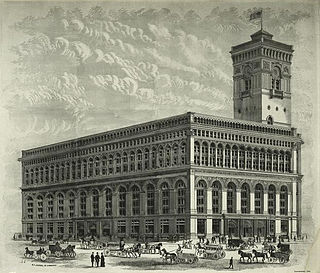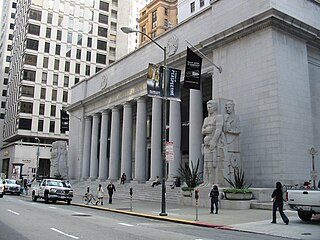| Type | Commodities and stock exchange |
|---|---|
| Location | New York City, United States |
| Founded | Circa May 1876 |
| Closed | July 26, 1877 |
The American Mining and Stock Exchange was a commodities and stock exchange in New York City. In 1877 it absorbed the competing New-York Open Gold and Stock Exchange. [1] The New York Mining Stock Exchange absorbed the members of the American Mining and Stock Exchange, which had been operating for around fifteen months, on July 26, 1877. [2]
The American Mining and Stock Exchange began operations around May 1876. [2]
Around early 1877, there was an attempt to consolidate the New-York Open Gold and Stock Exchange with the American Mining and Stock Exchange, both of which were next door to one-another in New York. [1] On June 8, 1877, the New York Times reported on another "shrewd" attempt to break up and dissolve the New-York Open Gold and Stock Exchange, and merge it with the American Mining and Stock Exchange. According to the committee proposals, the new exchange would be named The Consolidated Mining, Gold, and Stock Exchange of New-York." At the time, however, the committees of both exchanges had not come to an agreement on merging. The matter was decided on June 8 at an executive session. [1] Terms had been agreed on by June 14, 1877. L. W. Badger was appointed chairman. [3]
The New York Mining Stock Exchange returned to 60 Broadway on July 26, 1877, on which day it also absorbed the members of the American Mining and Stock Exchange. [2]

NYSE American, formerly known as the American Stock Exchange (AMEX), and more recently as NYSE MKT, is an American stock exchange situated in New York City. AMEX was previously a mutual organization, owned by its members. Until 1953, it was known as the New York Curb Exchange.

The New York Stock Exchange is an American stock exchange at 11 Wall Street in the Financial District of Lower Manhattan in New York City. It is by far the world's largest stock exchange by market capitalization of its listed companies at US$30.1 trillion as of February 2018. The average daily trading value was approximately US$169 billion in 2013. The NYSE trading floor is at 11 Wall Street and is composed of 21 rooms used for the facilitation of trading. An additional trading room, at 30 Broad Street, was closed in February 2007. The main building and the 11 Wall Street building were designated National Historic Landmarks in 1978.

Philadelphia Stock Exchange (PHLX), now known as NASDAQ OMX PHLX, is the oldest stock exchange in the United States. It is now owned by Nasdaq Inc. Founded in 1790, the exchange was originally named the Board of Brokers of Philadelphia, also referred to as the Philadelphia Board of Brokers. In 1875, the Board of Brokers changed its name to the Philadelphia Stock Exchange.
Anglo American plc is a British multinational mining company with headquarters in London, England. It is the world's largest producer of platinum, with around 40% of world output, as well as being a major producer of diamonds, copper, nickel, iron ore and metallurgical and thermal coal. The company has operations in Africa, Asia, Australia, Europe, North America and South America.

Newcrest Mining Limited is an Australian-based corporation which engages in the exploration, development, mining and sale of gold and gold-copper concentrate. It is Australia's leading gold mining company and its operations have expanded beyond Australia, for example Indonesia, thus becoming a prominent international mining corporation. Newmont Mining Corporation initially started the company as a subsidiary in 1966. The subsidiary became Newmont Holdings Pty Ltd. in 1980 and in 1990 acquired 100% of Australmin Holdings Ltd. taking the current name.
The Madras Stock Exchange (MSE) was a stock exchange in Chennai, India. The now defunct MSE was the fourth stock exchange to be established in the country and the first in South India. It had a turnover (2001) of ₹ 3,090 crore, but was a fraction of the turnover generated by the Bombay Stock Exchange and National Stock Exchange of India. The turnover of the stock exchange was 19,907 Crore as of the financial year 2012.

Broad Street is a north–south street in the Financial District in the New York City borough of Manhattan. It stretches from South Street to Wall Street.

The phrase curbstone broker or curb-stone broker refers to a broker who conducts trading on the literal curbs of a financial district. Such brokers were prevalent in the 1800s and early 1900s, and the most famous curb market existed on Broad Street in the financial district of Manhattan. Curbstone brokers often traded stocks that were speculative in nature, as well as stocks in small industrial companies such as iron, textiles and chemicals. Efforts to organize and standardize the market started early in the 20th century under notable curb-stone brokers such as Emanuel S. Mendels.

The New York Produce Exchange was a produce exchange at Bowling Green in Lower Manhattan, New York City. It was founded in 1861, and served a network of produce and commodities dealers across the United States. In the 1880s, it had the largest membership of any stock exchange in the United States.

The Consolidated Stock Exchange of New York, also known as the New York Consolidated Stock Exchange or Consolidated, was a stock exchange in New York City, New York in direct competition to the New York Stock Exchange (NYSE) from 1885–1926. It was formed from the merger of other smaller exchanges, and was referred to in the industry and press as the "Little Board." By its official formation in 1885, its membership of 2403 was considered the second largest membership of any exchange in the United States.
Consolidated National Bank of New York was a bank operating in New York City. Also referred to in the press as Consolidated National Bank, the institution was organized on July 1, 1902 with capital of $1 million. Wrote The New York Times, the bank was "founded with the idea of cornering the business of the Consolidated Exchange and its brokers." The bank opened for business at 57 Broadway on September 22, 1902, and a year later the bank took out a five-year lease at the Exchange Court Building. In 1906, the Consolidated Stock Exchange withdrew its deposits with the Consolidated National Bank. In 1909, the bank voted to acquire the assets of Oriental Bank and merge them with Consolidated, creating the National Reserve Bank. The Consolidated name was operative for a short time afterwards.
The National Petroleum Exchange was a resource exchange in New York City founded in 1882. In 1883 the National Petroleum Exchange and the New York Mining Stock Exchange were consolidated, becoming the New-York Mining Stock and National Petroleum Exchange. After several other exchange mergers with competitors, the exchange became the Consolidated Stock and Petroleum Exchange of New York, which in 1885 became the Consolidated Stock Exchange of New York.
The New-York Petroleum Exchange and Stock Board was a resource and stock exchange in New York City. Founded as the New-York Petroleum Exchange, in 1884 the exchange reported oil clearances amounting to 2,373,582,000 barrels, averaging 7,782,000 barrels per day. That year the exchange also began trading in stocks, bonds, and other securities. The institution merged with the competing exchange New-York Mining and National Petroleum Exchange on February 28, 1885, forming the Consolidated Stock and Petroleum Exchange.

The Baltimore Stock Exchange was a regional stock exchange based in Baltimore, Maryland. Opened prior to 1881, The exchange's building was destroyed by the Great Baltimore Fire of 1904, and was then located at 210 East Redwood Street in Baltimore's old financial district. In 1918, the exchange had 87 members, with six or seven members at the time serving the United States in World War I. The Baltimore Stock Exchange was acquired by the Philadelphia Stock Exchange in 1949, becoming the Philadelphia-Baltimore Stock Exchange. The Baltimore Stock Exchange Building was sold and renamed the Totman Building.

The San Francisco Stock and Bond Exchange was a regional stock exchange based in San Francisco, California, United States. Founded in 1882, in 1928 the exchange purchased and began using the name San Francisco Stock Exchange, while the old San Francisco Stock Exchange was renamed the San Francisco Mining Exchange. The San Francisco Curb Exchange was absorbed by the San Francisco Stock Exchange in 1938. In 1956 the San Francisco Stock Exchange merged with the Los Angeles Oil Exchange to create the Pacific Coast Stock Exchange.
The Open Board of Stock Brokers was an early regional stock exchange in the United States. It was established in 1864, "to profit from the economic and investment boom sparked by the Civil War."

The San Francisco Curb Exchange was a curb exchange opened in 1928, formed out of a re-organization of the San Francisco Stock and Bond Exchange and the San Francisco Mining Exchange. The San Francisco Curb Exchange replaced the Mining Exchange at the 350 Bush Street building. The Curb Exchange later left the building in 1938, when the Curb Exchange was absorbed by the San Francisco Stock Exchange.
The St. Louis Stock Exchange was a regional stock exchange located in St. Louis, Missouri. Opened in 1899, in September 1949, the St. Louis Stock Exchange was acquired by the Chicago Stock Exchange, and renamed the Midwest Stock Exchange.